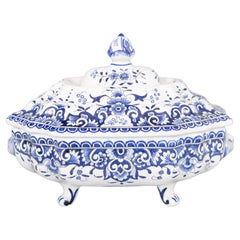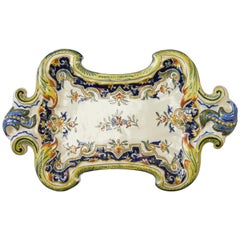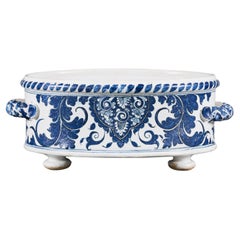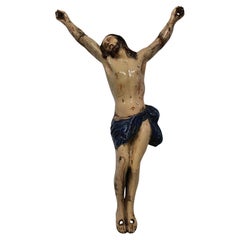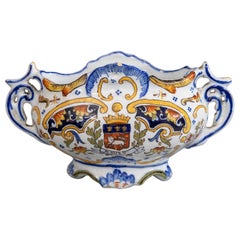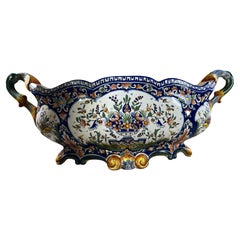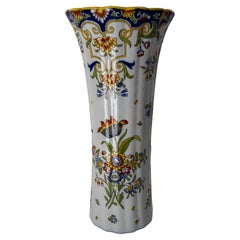Rouen Faience
to
14
103
43
64
56
40
36
28
26
11
10
7
5
5
4
3
2
2
2
1
1
1
1
1
1
1
1
62
1
1
1
Sort By
Antique French Rouen Faience Blue & White Tureen, circa 1900
By Rouen
Located in Pearland, TX
A lovely antique French Rouen faience blue and white ironstone soup tureen, circa 1900. No maker's
Category
Early 20th Century French Delft and Faience
Materials
Ceramic, Faience
French Rouen Faience Hand Painted Decorative Wall Plate
By Rouen
Located in Barntrup, DE
French Rouen faience decorative wall plate, hand painted with blue, green and yellow decors
Category
Mid-20th Century French Baroque Decorative Art
Materials
Ceramic, Faience
A Mid-19th Century Rouen Faience Jardinière Planter
Located in London, GB
France, circa 1850
A mid-nineteenth century Rouen faience jardinière, the oval body decorated with
Category
Antique Mid-19th Century French Planters and Jardinieres
Materials
Ceramic, Pottery
Rouen Faience Corpus
Located in Kent, Dover
A French faience corpus manufactured in Rouen. The cross now missing and with historic damage to
Category
Antique 1760s French Louis XV Sculptures and Carvings
Materials
Faience
Antique French Rouen Faience Jardiniere Cachepot, circa 1900
By Rouen
Located in Pearland, TX
A lovely antique petite French faience hand painted jardiniere / cachepot / planter from Rouen
Category
Antique Early 1900s French Planters, Cachepots and Jardinières
Materials
Faience
French Provincial Rouen Faience Floral Cornucopia Bird Butterfly Wall Decoration
By Rouen
Located in New York, NY
Large, vibrant French Provincial hand painted faience wall decoration in the shape of a cover
Category
20th Century French French Provincial Ceramics
Materials
Ceramic, Faience
$385
H 5.5 in Dm 13 in
Antique French Rouen Faience Jardiniere Cachepot – Hand-Painted Masterpiece
Located in LA FERTÉ-SOUS-JOUARRE, FR
Enhance your collection with this stunning antique French faience jardiniere/cachepot, a testament
Category
Antique Late 19th Century Planters and Jardinieres
Materials
Faience
$690
H 7.88 in W 22.05 in D 8.67 in
Beautiful Important Rouen Earthenweare in the Shape of a Young Bacchus, 18th C
By Rouen
Located in Marcq-en-Barœul, Hauts-de-France
branches and grapes. Rouen Faience. This is a French Work. Circa 18th Century.
Category
Antique 18th Century French Delft and Faience
Materials
Earthenware
$7,167 Sale Price
29% Off
H 22.45 in W 14.57 in D 11.82 in
French Vieux Rouen Faience Vase with Vegetal Patterns Art Nouveau, c. 1900
Located in Labrit, Landes
French faience vase from Rouen manufactures.
Features hand painted floral decor in a blue, orange
Category
Early 20th Century French Art Nouveau Vases
Materials
Faience
Hand Painted Antique French Faience Jardiniere, Decor Rouen, Circa 1900
Located in Dallas, TX
faience production since the mid-1500s. This lovely hand-painted jardiniere (circa 1900) is from Rouen and
Category
Antique Early 1900s French Delft and Faience
Materials
Ceramic, Faience
$1,400
H 10.75 in W 25.75 in D 12 in
French Faïence Oblong Octagonal Chinoiserie Tray (Bannette), Most likely Rouen
By Rouen
Located in Downingtown, PA
French Faïence Oblong Octagonal Chinoiserie Letter or Document Tray,
Circa 1730-1740,
Most likely
Category
Antique 1730s Georgian Delft and Faience
Materials
Faience
$7,800
H 2.25 in W 15.25 in D 9.63 in
Early 20th Century French Hand Painted Faience Serving Tray from Rouen
By Rouen
Located in Dallas, TX
Serve your guests in style with this exquisite antique French faience serving platter. Crafted in
Category
Early 20th Century French Delft and Faience
Materials
Faience
$875
H 1.25 in W 19 in D 11.25 in
Mid-Century French Hand Painted Faience Ewer Jar from Rouen Normandy
By Rouen
Located in Dallas, TX
Decorate a shelf or a counter with this antique "Aiguiere" (or ewer). Sculpted in Rouen, France
Category
Mid-20th Century French Delft and Faience
Materials
Ceramic, Faience
$775
H 13.25 in W 8.5 in D 4.5 in
Pair of Early 20th Century French Hand Painted Faience Vases from Rouen
By Rouen
Located in Dallas, TX
Enhance your mantel or table with this striking pair of antique faience vases. Crafted in Normandy
Category
Early 20th Century French Delft and Faience
Materials
Ceramic, Faience
$3,600 / set
H 25.5 in W 9.75 in D 7.25 in
19th Century French Hand Painted Oval Faience Wall Platter from Rouen
By Rouen
Located in Dallas, TX
This beautiful antique ceramic dish was crafted in Normandy, France, circa 1880. The stylized ceramic plate has a scalloped edge and depicts a hand painted courting scene with a viol...
Category
Antique Late 19th Century French Delft and Faience
Materials
Faience
$525
H 10.5 in W 15.25 in D 2 in
19th Century French Rouen Ceramic Plate
By Rouen
Located in Winter Park, FL
An early 19th century French glazed earthenware plate from Rouen, with a hand-painted country house
Category
Antique Early 19th Century French Country Delft and Faience
Materials
Ceramic
Early 20th Century French Hand Painted Wall Faience Lavabo Fountain with Stand
By Rouen
Located in Dallas, TX
Decorate a entry wall or hallway with this elegant antique ceramic fountain. Crafted in Rouen
Category
Early 20th Century French Louis XV Delft and Faience
Materials
Ceramic, Faience
$1,800
H 39 in W 14 in D 8.25 in
Ceramic Dish Ashtray or Centrepiece in Ceramic 19th Century Malicorne
Located in Auribeau sur Siagne, FR
Malicorne 19th century ashtray or centrepiece.
In the manner Rouen faiences.
Category
Antique 19th Century French French Provincial Ashtrays
Materials
Ceramic
$143 Sale Price
20% Off
H 0.79 in Dm 4.73 in
Faience Blue and White Water Cistern, Rouen or Lille, French Work, 18th Century
Located in Marcq-en-Barœul, Hauts-de-France
camaieu. Lateral grip in the shape of a lion's head. Earthenware from Rouen or Lille. French Work. Late
Category
Antique Late 17th Century French Neoclassical Delft and Faience
Materials
Earthenware
$5,543 Sale Price
28% Off
H 16.54 in Dm 10.63 in
19th Rouen Style Faience Ribbed Wall Cistern and Basin
By Rouen
Located in Marseille, FR
19th Rouen style Faience ribbed wall cistern and basin with decoration heads, carrying by 2 times
Category
Antique 19th Century European Ceramics
Materials
Faience
Early 20th Century French Hand-Painted Faience Vasse from Rouen
By Rouen
Located in Verviers, BE
The designs on this French faience group is typical of pottery made in Rouen.
Early 20th Century
Category
Early 20th Century French Ceramics
Materials
Faience
Early 20th Century French Hand-Painted Faience Vasse from Rouen
By Rouen
Located in Verviers, BE
The designs on this French faience group is typical of pottery made in Rouen.
Early 20th century
Category
Early 20th Century French Ceramics
Materials
Faience
Early 20th Century French Hand-Painted Faience Terrine from Rouen
By Rouen
Located in Verviers, BE
The designs on this French faience group is typical of pottery made in Rouen.
Early 20th century
Category
Early 20th Century French Ceramics
Materials
Faience
Early 20th Century French Hand-Painted Faience Candlestick from Rouen
By Rouen
Located in Verviers, BE
The designs on this French faience group is typical of pottery made in Rouen.
Early 20th Century
Category
Early 20th Century French Ceramics
Materials
Faience
Rare French Faience Pitcher with Lid Rouen Style, Circa 1900
By Rouen
Located in Austin, TX
Rare French Faience Pitcher with lid Rouen style Circa 1900.
Floral painting and cornucopia.
Category
Antique Early 1900s French French Provincial Pitchers
Materials
Faience
Pair of Mid-Century French Faience Candlesticks from Rouen Normandy
By Rouen
Located in Dallas, TX
Crafted in Rouen Normandy, France, circa 1960, each colorful candlestick stands on scrolled feet
Category
Mid-20th Century French Candlesticks
Materials
Faience, Ceramic
$675 / set
H 9.25 in W 4 in D 4 in
Early 20th Century French Hand-Painted Faience Large Vasse from Rouen
By Rouen
Located in Verviers, BE
The designs on this French faience group is typical of pottery made in Rouen.
Early 20th century
Category
Early 20th Century French Ceramics
Materials
Faience
Mid-19th Century French Hand Painted Faience Jardinière from Rouen
By Rouen
Located in Dallas, TX
bottom Rouen with marking.
Size: 26.25" W x 9" D x 7" H.
Category
Antique Mid-19th Century French Louis XV Planters, Cachepots and Jardini...
Materials
Ceramic, Faience
Pair of 19th Century French Hand Painted Faience Vases from Rouen
By Rouen
Located in Dallas, TX
traditional blue, white and yellow Rouen palette; they are further embellished with the Normandy crest decor
Category
Antique Late 19th Century French Vases
Materials
Ceramic, Faience
Mid-Century French Louis XV Hand Painted Faience Oval Jardinière from Rouen
By Rouen
Located in Dallas, TX
Crafted in Rouen, France circa 1940, the antique ceramic planter sits on escargot feet over a
Category
Mid-20th Century French Louis XV Planters, Cachepots and Jardinières
Materials
Ceramic, Faience
$825
H 8 in W 18.5 in D 9.5 in
Early 20th Century French Louis XV Hand Painted Faience Clock from Rouen
By Rouen
Located in Dallas, TX
table. Crafted in Rouen, France, circa 1920, the colorful mantel clock features a rich Rococo influence
Category
Early 20th Century French Louis XV Mantel Clocks
Materials
Ceramic, Faience, Porcelain
$1,300
H 9.5 in W 5.5 in D 6.75 in
Pair of Mid-Century French Hand Painted Faience "Saint Clement" Urns with Lids
By Saint-Clément
Located in Dallas, TX
. Stamped on the bottom "Saint Clement, Fait Main, Tradition Rouen".
The Faience of Luneville - Saint
Category
Mid-20th Century French Delft and Faience
Materials
Ceramic, Faience
$1,200 / set
H 20 in W 10 in D 7 in
Late 19th Century Rouen French Armorial Cake Stand Display Plate Faience Crest
By Rouen
Located in Hyattsville, MD
W 13 3/8 x D 11 5/8 x H 6 5/8 in Plate Rim H 5 in
Many chips to glazed edges. Crafted in Normandy, France, c.1880. Round in shape with scalloped rims, and arching handles, hand pai...
Category
Antique Late 19th Century French Victorian Serving Pieces
Materials
Ceramic
$995
H 6.63 in W 13.38 in D 11.63 in
Vase - Rouen earthenware fountain, flower pot - blue white - 18th century France
By Rouen
Located in Beuzevillette, FR
flowers.
France, Rouen - 18th Century
From the 16th century, Rouen earthenware acquired an
Category
Antique 18th Century French Vases
Materials
Faience
$692
H 20.87 in W 9.65 in D 5.91 in
19th Century French Hand Painted Faience Jardinière from Normandy
By Rouen
Located in Dallas, TX
Crafted in Rouen, France circa 1890, and oval in shape, the antique planter stands on scrolled feet
Category
Antique Late 19th Century French Louis XV Planters, Cachepots and Jardin...
Materials
Ceramic, Faience
Early 20th Century, French Hand Painted Faience Planter from Normandy
By Rouen
Located in Dallas, TX
hand painted floral decor in a blue, orange, white and yellow palette. The faience, urn-shaped vase has
Category
Early 20th Century French Planters, Cachepots and Jardinières
Materials
Ceramic, Faience
19th Century French Hand-Painted Faience Cache Pot from Desvres
By Rouen
Located in Dallas, TX
Decorate a mantle, table or buffet with this colorful antique planter. Sculpted in Normandy France circa 1880, and octagonal in shape, the ceramic jardiniere is decorated with hand p...
Category
Antique Late 19th Century French Planters, Cachepots and Jardinières
Materials
Ceramic, Faience
Pair of 19th Century French Hand Painted Faience Trumpet Vases from Normandy
By Rouen
Located in Dallas, TX
floral and foliage decors including a royalty crown and a fox. Both faience vases are in excellent
Category
Antique Late 19th Century French Vases
Materials
Ceramic, Faience
$875 / set
H 13.25 in W 4 in D 4 in
Antique French Faience Lidded Bowl Tureen Hand Painted with Flowers and Insects
By Rouen
Located in Firenze, IT
A French 18th century large polychrome Faience lidded soup toureen or entree dish with scallop
Category
Antique 18th Century French Rococo Decorative Bowls
Materials
Maiolica, Porcelain, Pottery, Faience
$2,389
H 8.67 in Dm 13.39 in
ROUEN, XVIIIème - Suite en faïence de 2 PLATS
Located in ROUEN, FR
ROUEN, XVIIIème - Suite en faïence de 2 PLATS à contours chantournées et décors grand feu
Category
18th Century French School More Art
Materials
Faience
A Good Pair of French Blue&White Tin-Glazed Faience Pitchers
By Rouen
Located in San Francisco, CA
A good pair of French blue and white tin-glazed faience pitchers or ewers; probably Rouen; each
Category
Antique 19th Century French Pitchers
19th Century Set of Ten French Painted Faience Plates and Dishes from Normandy
By Rouen
Located in Dallas, TX
Colorful set of antique wall dishes from Rouen, France, handcrafted, circa 1880, the set includes
Category
Antique Late 19th Century French Ceramics
Materials
Ceramic
$950 / set
H 2 in Dm 13 in
19th Century French Faience Harlequin Cachepot, Rouen double-Sided Expression
Located in Hamburg, DE
This exceptional 19th-century French faience cachepot from Rouen is a rare and whimsical piece that
Category
Antique 19th Century French Charles X Planters, Cachepots and Jardinières
Materials
Ceramic
$1,111
H 6.3 in W 8.27 in D 8.67 in
19th C. Pair Faience of Rouen Summer & Winter Garniture Bust Sculpture Statue LA
Located in West Hollywood, CA
19th C. Pair Faience of Rouen Summer & Winter Garniture Bust Sculpture Statue LA ,The two
Category
Antique 19th Century French Busts
Materials
Faience, Paint
$19,000 / set
H 21 in W 14 in D 7 in
French Porcelain Faience Rouen Double Handled Urn Jardiniere Pot 21"
Located in Dayton, OH
French faience enameled porcelain urn / jardiniere / planter / cachepot featuring an ornate
Category
20th Century Urns
Materials
Porcelain
$1,680 Sale Price
20% Off
H 15 in W 21 in D 14 in
Art Deco Silver Overlay and Black Ceramic Vase by Ceram France, 1930s
By Rouen
Located in Atlanta, GA
Ceram, Rouen, France, designed and crafted this stylish 1930s French Art Deco black ceramic vase
Category
Vintage 1930s French Art Deco Vases
Materials
Ceramic, Faience
Allegorical Pair of Faience de Rouen Busts Depicting Summer and Fall
By Edmé Samson
Located in Vancouver, British Columbia
Two Faience de Rouen busts on plinths spuriously inscribed "Fait a Rouen 1647" and blue fleur-de
Category
Antique Late 19th Century French Rococo Revival Wall-mounted Sculptures
Materials
Porcelain
$6,500 / item
H 34 in W 16 in D 7 in
Pair of Large French Planters
By Rouen
Located in Buenos Aires, Argentina
-year royal monopoly on the production of faience in Rouen. In 1647, a factory owned by Edme Poterat
Category
Antique Early 1900s French Empire Ceramics
Materials
Ceramic
French Faience Teapot Desvres, Circa 1900
By Desvres
Located in Austin, TX
French Faience teapot Desvres, Rouen style Circa 1900.
Coat of arms and floral pattern.
Category
Antique Early 1900s French Rustic Tea Sets
Materials
Faience
Group of Two French Faience Ink Wells, 19th Century
Located in Savannah, GA
, circular, decorated in the Rouen style, faience inkwell (5" diameter), circa 1898. Henri Delcourt of
Category
Antique 19th Century French Inkwells
Materials
Faience
Large Majolica Dish France Rouen Manufactory of Jean-Baptiste Guillibaud, 1730
Located in Puglia, Puglia
Big dish.
France, Rouen, Manufactory of Jean-Baptiste Guillibaud, around 1730.
Majolica. Brand: "Gb
Category
Antique 1730s French Rococo Platters and Serveware
Materials
Maiolica
$2,926 Sale Price
30% Off
H 2.37 in Dm 17.33 in
Set of Eight Rouen Faience Jars
Located in Chilton, GB
A rare set of 'faiences de Rouen' apothecary jars by 'Maison Fernette'.
The set is comprised of
Category
Mid-20th Century French Jars
Materials
Porcelain
Monumental 19th Century French Rouen Faience Bust of "Winter"
Located in San Francisco, CA
A masterpiece of modeling from a series of five enormous faience busts originally commissioned in
Category
Antique 19th Century French Busts
Important Early 18th Century Octagonal Faience Platter or 'Bannette', Rouen
By Rouen
Located in London, GB
. With two handles, one at each end.
Rouen, France, circa 1710.
A small amount of restoration to the
Category
Antique Early 18th Century French Louis XIV Delft and Faience
Materials
Faience
$6,154
H 2.17 in W 18.9 in D 11.62 in
18th Century Blue and White Faience 'Bassin' or Jardiniere, France, circa 1760
By Rouen
Located in London, GB
geometric floral designs in blue and black on a milky white background.
Rouen, France circa 1760. Old
Category
Antique 18th Century French Louis XV Delft and Faience
Materials
Faience
$1,188
H 3.75 in W 12.21 in D 8.27 in
Pair of Antique Rouen Vases
Located in Chicago, IL
glazes that made Rouen faience so famous. The delicate paisley pattern begins at the very top of the vase
Category
Antique 19th Century French Country Vases
Materials
Porcelain
Rouen 'France' Faience Plate with Nielloed Decoration, circa 1725
Located in Paris, FR
A Rouen (France) faience plate with nielloed ochre decoration with a rosace in the center and work
Category
Antique 1720s French Regency Delft and Faience
Materials
Faience
18th Century Rouen Blue And White Faience Wall Fountain
Located in London, GB
Surmounted by two dolphins encircling a shell, decorated with blue and magnanese camaïeu of bouquets of flowers, floral lambrequins on the base. Blue threads on the edges, the spout ...
Category
Antique Mid-18th Century French Baroque Delft and Faience
Materials
Faience
- 1
Get Updated with New Arrivals
Save "Rouen Faience", and we’ll notify you when there are new listings in this category.
Rouen Faience For Sale on 1stDibs
Choose from an assortment of styles, material and more with respect to the rouen faience you’re looking for at 1stDibs. A rouen faience — often made from ceramic, earthenware and faience — can elevate any home. There are many kinds of the rouen faience you’re looking for, from those produced as long ago as the 18th Century to those made as recently as the 20th Century. A rouen faience, designed in the Louis XV, Baroque or Rococo style, is generally a popular piece of furniture. You’ll likely find more than one rouen faience that is appealing in its simplicity, but Rouen, Antoine Montagnon and Fourmaintraux-Frères produced versions that are worth a look.
How Much is a Rouen Faience?
A rouen faience can differ in price owing to various characteristics — the average selling price 1stDibs is $898, while the lowest priced sells for $287 and the highest can go for as much as $25,000.
